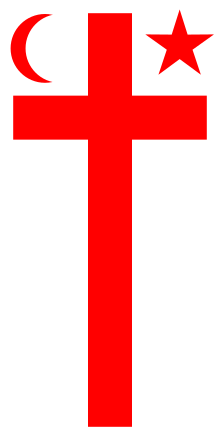
Back ميغماك Arabic Микмакал AV Мікмак Byelorussian Микмаки Bulgarian Micmac Catalan Mikmakové Czech Mi’kmaq German Mikmakoj Esperanto Micmac Spanish Mikmakid Estonian
Lnu | |
|---|---|
 Grand Council Flag of the Miꞌkmaq Nation.[1][2] Although the flag is meant to be displayed hanging vertically as shown here, it is quite commonly flown horizontally, with the star near the upper hoist. | |
 A Miꞌkmaw father and child at Tufts Cove, Nova Scotia, around 1871 | |
| Total population | |
| 66,748 registered members (2023) 168,480 claimed Mi'kmaq ancestry (2016)[3] | |
| Regions with significant populations | |
| (Mi'kma'ki, Dawnland) Canada, United States | |
| Newfoundland and Labrador | 28,282 |
| Nova Scotia | 18,814 |
| New Brunswick | 9,025 |
| Quebec | 7,655 |
| Maine | 1,489 |
| Prince Edward Island | 1,483 |
| Languages | |
| English, Miꞌkmaq, French | |
| Religion | |
| Native American religion, Christianity, others | |
| Related ethnic groups | |
| Other Algonquian peoples Especially Abenaki, Maliseet, Passamaquoddy, Penobscot | |
| Person | Lnu |
|---|---|
| People | Lnu'k (Mi'kmaq) |
| Language | Mi'kmawi'simk |
| Country | Mi'kma'ki Wabanaki |
The Mi'kmaq (also Mi'gmaq, Lnu, Miꞌkmaw or Miꞌgmaw; English: /ˈmɪɡmɑː/ MIG-mah; Miꞌkmaq: [miːɡmaɣ])[4][5][6] are a First Nations people of the Northeastern Woodlands, indigenous to the areas of Canada's Atlantic Provinces, primarily Nova Scotia, New Brunswick, Prince Edward Island, and Newfoundland,[7] and the Gaspé Peninsula of Quebec as well as Native Americans in the northeastern region of Maine. The traditional national territory of the Mi'kmaq is named Miꞌkmaꞌki (or Miꞌgmaꞌgi).
There are 66,748 Mi'kmaq people in the region as of 2023, (including 25,182 members in the more recently formed Qalipu First Nation in Newfoundland.[8][9]) According to the Canadian 2021 census, 9,245 people claim to speak Miꞌkmaq, an Eastern Algonquian language.[10] Once written in Miꞌkmaw hieroglyphic writing, it is now written using most letters of the Latin alphabet.
The Mi'kmaq, Maliseet, and Pasamaquoddy nations signed a series of treaties known as the Covenant Chain of Peace and Friendship Treaties with the British Crown throughout the eighteenth century; the first was signed in 1725, and the last in 1779. The Miꞌkmaq maintain that they did not cede or give up their land title or other rights through these Peace and Friendship Treaties.[11] The landmark 1999 Supreme Court of Canada decision in R v Marshall upheld the 1752 Peace and Friendship Treaty "which promised Indigenous Peoples the right to hunt and fish their lands and establish trade."[12]
The Miꞌkmaw Grand Council is the official authority that engages in consultation with the Canadian federal government and the provincial government of Nova Scotia, as established by the historic August 30, 2010 agreement with the Miꞌkmaq Nation, resulting from the Miꞌkmaq–Nova Scotia–Canada Tripartite Forum.[13] This collaborative agreement, which includes all the First Nations within the province of Nova Scotia, was the first in Canadian history.[13]
Historically the Santé Mawiómi, or Grand Council, which was made up of chiefs of the district councils of Miꞌkmaꞌki, was the traditional senior level of government for the Miꞌkmaw people. The 1876 Indian Act disrupted that authority, by requiring First Nations to establish representative elected governments along the Canadian model, and attempting to limit the Council's role to spiritual guidance.[14][15]
- ^ https://www.benoitfirstnation.ca/grandCouncil_flag_symbolism.html
- ^ https://www.benoitfirstnation.ca/mikmaq_flags_symbolism.html
- ^ "Aboriginal Ancestry Responses (73)". www12.statcan.gc.ca. Government of Canada. 2017-10-25. Retrieved 2017-11-23.
- ^ "Native Languages of the Americas: Mi'kmaq Language (Mi'kmaw, Micmac, Mikmaq, Mikmak)". Native-Languages.org. Retrieved October 31, 2018.
- ^ Lockerby, Earle (2004). "Ancient Miꞌkmaq Customs: A Shaman's Revelations" (PDF). The Canadian Journal of Native Studies. 24 (2): 403–423. see page 418, note 2
- ^ Sock, S., & Paul-Gould, S. (2011). Best Practices and Challenges in Miꞌkmaq and Maliseet/Wolastoqi Language Immersion Programs.
- ^ Gallant, David Joseph (2008). "Mi'kmaq". The Canadian Encyclopedia. Retrieved 2023-07-23.
- ^ "Programs and Services". Qalipu.ca.
- ^ "Thousands of Qalipu Miꞌkmaq applicants rejected again", CBC, Dec 08, 2017.
- ^ Government of Canada, Statistics Canada (2022-02-09). "Profile table, Census Profile, 2021 Census of Population – Canada [Country]". www12.statcan.gc.ca. Retrieved 2023-06-14.
- ^ Bernard, Tim; Rosenmeier, Leah Morine; Farrell, Sharon L., eds. (2015). Mi'kmawe'l Tan Teli-kina'muemk Teaching About the Mi'kmaq (PDF). The Mi'kmawey Debert Cultural Centre. p. 106.
- ^ Cite error: The named reference
CBC_Bunsale_20201018was invoked but never defined (see the help page). - ^ a b Cite error: The named reference
TripartiteForum1997was invoked but never defined (see the help page). - ^ Julien, Donald M. (October 2007). Kekina'muek (learning)Learning about the Mi'kmaq of Nova Scotia (PDF). Eastern Woodland Print Communication. p. 11. Retrieved 21 February 2020.
- ^ "Mi'kmaq Historical Overview". Cape Breton University. Retrieved 21 February 2020.
© MMXXIII Rich X Search. We shall prevail. All rights reserved. Rich X Search